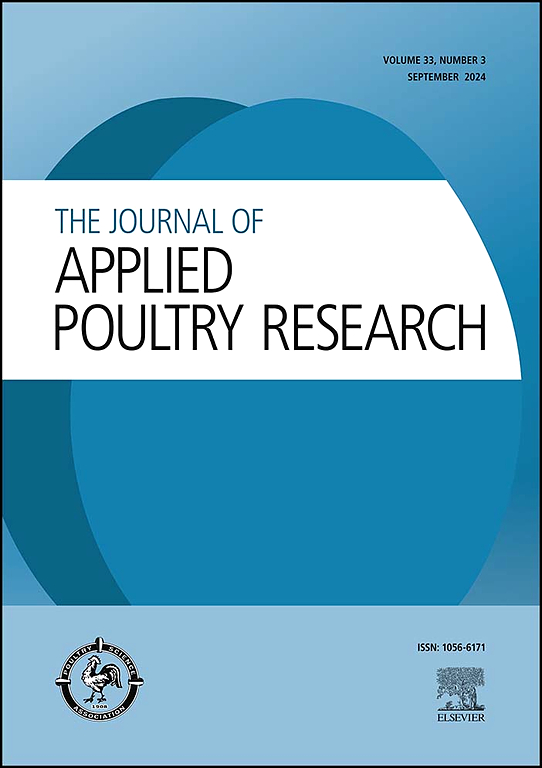吞吐量剂减轻了对低水分玉米和大颗粒模厚度颗粒肉鸡饲料的担忧
IF 2
3区 农林科学
Q2 AGRICULTURE, DAIRY & ANIMAL SCIENCE
引用次数: 0
摘要
低水分玉米,由于收获晚和/或处理和储存不当,可能会对颗粒产量(PPR)和颗粒耐久性指数(PDI)产生负面影响。这可能是由于较少的润滑和颗粒团聚与较低的水分含量有关。最近,Azomite®(AZM)与32、38和45 mm的颗粒模具厚度(PDT)结合进行了测试,结果表明,在每个PDT中,加入0.25%的AZM增加了PPR,并在很大程度上维持了PDI。此外,过去的研究表明,加入1.50至3.00 %的混合水(MAW)可以提高PPR和PDI。因此,本试验旨在研究PDT、AZM和MAW对低水分玉米肉鸡生长饲粮PPR、PDI测试30秒(PDI-30)、PDI测试60秒(PDI-60)和热粒温度(HPT)的影响。与先前发表的文献相比,修改PDT对PPR和PDI的影响相似,其中增加PDT导致PPR下降和PDI增加。此外,加入0.25% AZM和1.50% MAW后,PPR也有类似的增加;然而,这些影响并不是相加的。由此可见,AZM和MAW是提高饲料生产效率和饲料质量的有效饲料添加剂。然而,应该考虑到与1.5% MAW夹杂物相关的颗粒模具堵塞和滑动的轶事事件,因为这些可能导致高质量饲料产量的总体下降。本文章由计算机程序翻译,如有差异,请以英文原文为准。
Throughput agents alleviate concerns about pelleting broiler feed with low-moisture corn and large pellet die thicknesses
Low-moisture corn, due to late harvesting and/or improper handling and storage, may negatively impact the pellet production rate (PPR) and pellet durability index (PDI). This is likely due to less lubrication and particle agglomeration associated with the lower moisture content. Recently, Azomite® (AZM) was tested in combination with 32-, 38-, and 45 mm pellet die thicknesses (PDT), which showed that incorporating 0.25 % AZM increased PPR and largely maintained PDI relative to the 0.0 % AZM control within each PDT. Additionally, past research has shown that the inclusion of mixer-added water (MAW) at levels of 1.50 to 3.00 % can increase PPR and PDI. Therefore, the objective of this experiment was to determine the influence of PDT, AZM, and MAW on PPR, PDI tested for 30 sec (PDI-30), PDI tested for 60 sec (PDI-60), and hot pellet temperature (HPT) of a broiler grower diet manufactured with low-moisture corn. Modifying PDT had a similar effect on PPR and PDI relative to previously published literature, where increasing PDT resulted in decreased PPR and increased PDI. Additionally, the incorporation of 0.25 % AZM and 1.50 % MAW returned similar increases in PPR; however, these effects were not additive. It could, therefore, be concluded that AZM and MAW are effective feed additives to increase feed manufacturing efficiency and/or feed quality. However, the anecdotal incidents of plugs and slips at the pellet die associated with the 1.5 % MAW inclusion should be considered, as these may cause an overall decrease in high-quality feed production.
求助全文
通过发布文献求助,成功后即可免费获取论文全文。
去求助
来源期刊

Journal of Applied Poultry Research
农林科学-奶制品与动物科学
CiteScore
4.10
自引率
10.50%
发文量
80
审稿时长
104 days
期刊介绍:
The Journal of Applied Poultry Research (JAPR) publishes original research reports, field reports, and reviews on breeding, hatching, health and disease, layer management, meat bird processing and products, meat bird management, microbiology, food safety, nutrition, environment, sanitation, welfare, and economics. As of January 2020, JAPR will become an Open Access journal with no subscription charges, meaning authors who publish here can make their research immediately, permanently, and freely accessible worldwide while retaining copyright to their work. Papers submitted for publication after October 1, 2019 will be published as Open Access papers.
The readers of JAPR are in education, extension, industry, and government, including research, teaching, administration, veterinary medicine, management, production, quality assurance, product development, and technical services. Nutritionists, breeder flock supervisors, production managers, microbiologists, laboratory personnel, food safety and sanitation managers, poultry processing managers, feed manufacturers, and egg producers use JAPR to keep up with current applied poultry research.
 求助内容:
求助内容: 应助结果提醒方式:
应助结果提醒方式:


